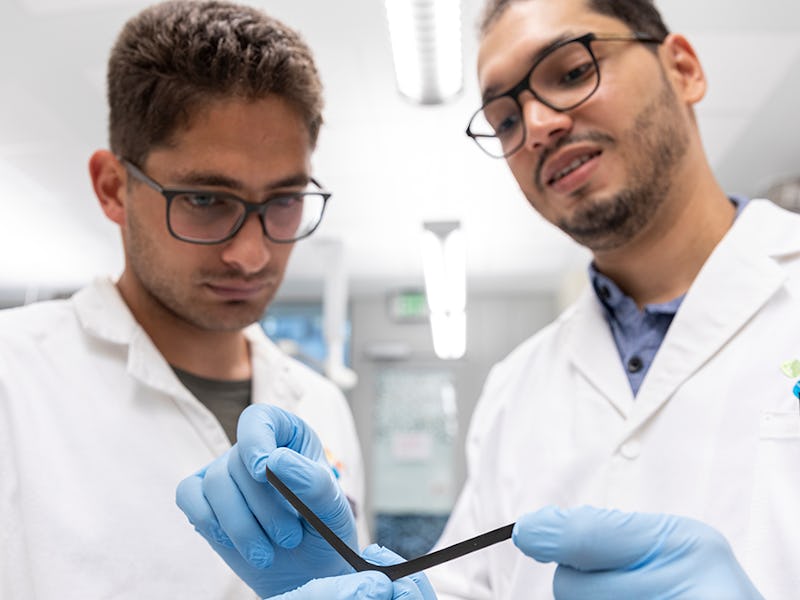Magnetic skin could literally open doors for you
A team promises you can use Jedi-like powers to manipulate wired devices.

Ready to open doors, type on keyboards, and control the world around you with just a wave of your hand?
Scientists at the King Abdullah University of Science and Technology announced Tuesday they have developed a “magnetic skin” which they claim is the first of its kind. The creation can control devices by waving a hand or blinking an eye. It’s lightweight, flexible, magnetized and does not require any batteries of any kind. Their research has been published in the journal Advanced Materials Technologies.
“Artificial electronic skins typically require a power supply and data storage or a communication network. This involves batteries, wires, electronic chips and antennas and makes the skins inconvenient to wear,” electrical engineer Jurgen Kosel, who led the project, said in a statement. “Our magnetic skin does not require any of this. To the best of our knowledge, it is the first of its kind.”
It’s the latest step forward in the world of helping humans interact faster with machines. Apple has seen big success with its wearables line, including the Apple Watch and voice-activated AirPods, which enable users to complete tasks without lifting a finger. The line could blur even further with ventures like Neuralink, founded by Elon Musk to develop an invasive brain-computer interface.
With these new models, users could speed up interactions with an increasingly-connected world. Magnetic skin could help users interact with a smart home, flicking light switches or opening automatic doors. It could help people with limited mobility interact with a machine. In the case of brain linkups, it could potentially avoid A.I. taking over the human race, as Musk fears.
Liam Swanepole (left) and Abdullah Almansouri demonstrate the flexibility of the electronic skin.
Magnetic skin: how it works
The system uses a biocompatible polymer matrix, which uses magnetized micro-particles. The design is highly flexible, and fabrication is simple and straightforward.
“It can be customized into any shape and color, making it imperceptible or even stylish,” KAUST student, Abdullah Almansouri, said in a statement. The fabrication process is inexpensive and simple. “Anyone can start their own artificial skin project after a few minutes of training if they have the tools and materials.”
It could also be applied to eye movements. The team added their skin to an eyelid, placing a multi-axis magnetic sensor in the vicinity. The magnetic field relayed movement data regardless of whether the eyelid was open or closed.
It seems like a fun advancement in wearable technology, but it could serve an important purpose. The team is aiming to apply the skin to new applications like a gesture-controlled wheelchair, a human-computer interface that doesn’t require any contact, and the ability to localize biomedical devices non-invasively.
In the case of the eye connections, it could monitor users in a number of situations. It could enable human-computer interactions for people with paralysis, or for providing extra shortcuts for video games. It could analyze sleep patterns, perhaps when incorporated into an eye mask. It could even monitor eye conditions, say when driving a car to ensure alertness.
Computer-machine interaction may be just the beginning, but as with many advancements of this nature, its best uses may not materialize until much later.
Read the abstract below:
Flexible and wearable magnetoelectronics add intriguing new functionalities to natural perception. Of particular interest regarding these artificial skins are wireless sensing and touchless interactions. Biocompatibility and imperceptibility are the most significant features of devices attached to the bodies. A biocompatible magnetic skin is introduced. It offers extreme flexibility, stretchability (>300%), and is lightweight, while maintaining a remanent magnetization up to 360 mT. It is comfortable to wear, can be realized in any desired shape or color, and adds tunable permanent magnetic properties to the surface it is applied to. It provides remote control functions and is combined with magnetic sensors; it implements a complete wearable magnetic system. For example, eye tracking is realized by attaching the magnetic skin to the eyelid. The advantage that it does not require any wiring makes it an extremely viable solution for soft robotics and human–machine interactions. Wearing the magnetic skin on a finger or integrated into a glove allows for remote gesture control. This type of application opens the door to new control concepts, relevant for people with disabilities, sterile environments, or the consumer industry.